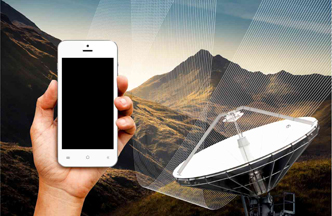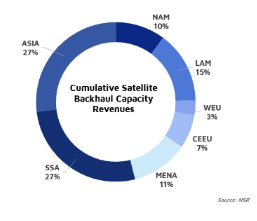The Satellite Cellular Backhaul Market
 According to the Ericsson Mobility Report, at the end of 2019 there were 7.9 billion mobile subscriptions, projected to grow to 8.9 billion by 2025. In spite of these large numbers, in 2020 over three billion people in the world, still have no access to any kind of fixed or mobile service. Usually mobile networks are the first step in providing connectivity to unserved areas. Unserved means no fiber or terrestrial backbone. Satellite is the ideal way to connect these regions.
According to the Ericsson Mobility Report, at the end of 2019 there were 7.9 billion mobile subscriptions, projected to grow to 8.9 billion by 2025. In spite of these large numbers, in 2020 over three billion people in the world, still have no access to any kind of fixed or mobile service. Usually mobile networks are the first step in providing connectivity to unserved areas. Unserved means no fiber or terrestrial backbone. Satellite is the ideal way to connect these regions. NSR’s Wireless Backhaul via Satellite, 14th Edition report, forecasts US$ 39 billion in 2019-2029 cumulative capacity revenues for Satellite Backhaul. With backhaul networks rapidly transitioning to 4G and the installed base continuously expanding, Mobile Backhaul via Satellite offers sizable opportunities in all regions. Small cells will play an increasingly important role in this growth, as lower costs expand the addressable market to areas previously uncovered due to industry cost metrics, according to NSR.
NSR’s Wireless Backhaul via Satellite, 14th Edition report, forecasts US$ 39 billion in 2019-2029 cumulative capacity revenues for Satellite Backhaul. With backhaul networks rapidly transitioning to 4G and the installed base continuously expanding, Mobile Backhaul via Satellite offers sizable opportunities in all regions. Small cells will play an increasingly important role in this growth, as lower costs expand the addressable market to areas previously uncovered due to industry cost metrics, according to NSR.
 |
| To read or download a pdf of the full report on Satellite Cellular Backahul sponsored by ST Engineering iDirect click here. |
As already mentioned, NSR is forecasting that by 2029 there will be 800,000 satellite backhaul sites in operation. This is due to mobile users consuming ever greater amounts of bandwidth, usually in the form of video, forcing MNOs to install more base stations to accommodate this. Small cells are now widely deployed and this trend will increase with 5G, A typical 5G network will be a mixture of small cells for millimeter wave coverage and larger base stations for wide area coverage.
-----------------------------
 Elisabeth Tweedie has over 20 years experience at the cutting edge of new commmunications entertainment technologies. She is the founder and President of Definitive Direction (www.definitivedirection.com), a consultancy that focuses on researching and evaluating the long-term potential for new ventures, initiating their development, and identifying and developing appropriate alliances. During her 10 years at Hughes Electronics, she worked on every acquisition and new business that the company considered during her time there. She can be reached at etweedie@definitivedirection.com
Elisabeth Tweedie has over 20 years experience at the cutting edge of new commmunications entertainment technologies. She is the founder and President of Definitive Direction (www.definitivedirection.com), a consultancy that focuses on researching and evaluating the long-term potential for new ventures, initiating their development, and identifying and developing appropriate alliances. During her 10 years at Hughes Electronics, she worked on every acquisition and new business that the company considered during her time there. She can be reached at etweedie@definitivedirection.com





